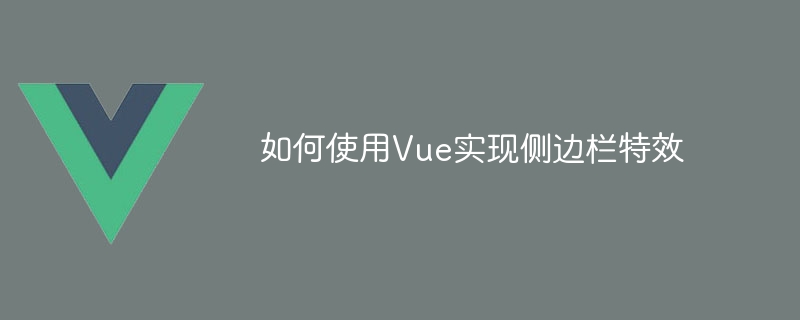如何使用Vue實現側邊欄特效

如何使用Vue實現側邊欄特效
Vue是一款流行的JavaScript框架,它的簡單易用和靈活性使開發人員能夠快速建立交互性強的單頁面應用程式。在這篇文章中,我們將學習如何使用Vue來實現一個常見的側邊欄特效,同時提供具體的程式碼範例幫助我們更好地理解。
- 建立Vue專案
首先,我們需要建立一個Vue專案。可以使用Vue提供的Vue CLI(命令列介面),它能夠快速產生一個基本的Vue專案結構。
開啟終端,並在專案所在的目錄中輸入以下命令:
$ vue create sidebar-animation
然後依照提示進行選擇所需的設定。
- 建立元件
接下來,我們需要建立兩個元件,一個是側邊欄元件,另一個是主內容元件。
在src資料夾下建立兩個檔案:Sidebar.vue和MainContent.vue。
Sidebar.vue程式碼:
<template>
<div class="sidebar">
<ul>
<li v-for="item in menuItems" :key="item.id" @click="selectItem(item)">
{{ item.name }}
</li>
</ul>
</div>
</template>
<script>
export default {
data() {
return {
menuItems: [
{ id: 1, name: "Home" },
{ id: 2, name: "About" },
{ id: 3, name: "Contact" },
],
};
},
methods: {
selectItem(item) {
// 在这里可以触发对应的路由跳转或者显示相应的内容
console.log(item.name);
},
},
};
</script>
<style scoped>
.sidebar {
width: 200px;
height: 100vh;
background-color: #f0f0f0;
padding: 10px;
}
ul {
list-style-type: none;
}
li {
margin-bottom: 10px;
cursor: pointer;
}
</style>MainContent.vue程式碼:
<template>
<div class="main-content">
<h1 id="selectedItem">{{ selectedItem }}</h1>
</div>
</template>
<script>
export default {
data() {
return {
selectedItem: "",
};
},
};
</script>
<style scoped>
.main-content {
padding: 10px;
}
</style>在這裡,我們建立了一個簡單的側邊欄元件和一個主內容元件。側邊欄元件中定義了一個選單項目數組,並透過v-for指令將其渲染為一個個的li元素。點擊每個選單項目時,透過綁定的click事件觸發selectItem方法,並將選取的選單項目傳遞過去。主內容元件中則展示了選取的選單項目名稱。
- 使用元件
在App.vue中使用剛才建立的兩個元件。
<template>
<div id="app">
<Sidebar />
<MainContent />
</div>
</template>
<script>
import Sidebar from "./components/Sidebar.vue";
import MainContent from "./components/MainContent.vue";
export default {
components: {
Sidebar,
MainContent,
},
};
</script>
<style>
#app {
display: flex;
height: 100vh;
}
</style>這裡我們將Sidebar元件和MainContent元件都引入,並在模板中使用這兩個元件。
- 運行專案
完成上述步驟後,我們可以在終端機中執行以下命令啟動專案:
$ npm run serve
然後,在瀏覽器中打開http://localhost:8080,就可以看到一個有側邊欄特效的頁面了。
結語
透過這篇文章,我們學習如何使用Vue來實現一個側邊欄特效。我們創建了一個側邊欄元件和一個主內容元件,並使用Vue的資料綁定和事件綁定來實現元件間的通訊。同時,我們也提供了具體的程式碼範例,幫助讀者更好地理解和使用Vue。希望這篇文章能對你有幫助,讓你更好地使用Vue來建立網頁應用程式。
以上是如何使用Vue實現側邊欄特效的詳細內容。更多資訊請關注PHP中文網其他相關文章!

熱AI工具

Undresser.AI Undress
人工智慧驅動的應用程序,用於創建逼真的裸體照片

AI Clothes Remover
用於從照片中去除衣服的線上人工智慧工具。

Undress AI Tool
免費脫衣圖片

Clothoff.io
AI脫衣器

Video Face Swap
使用我們完全免費的人工智慧換臉工具,輕鬆在任何影片中換臉!

熱門文章

熱工具

記事本++7.3.1
好用且免費的程式碼編輯器

SublimeText3漢化版
中文版,非常好用

禪工作室 13.0.1
強大的PHP整合開發環境

Dreamweaver CS6
視覺化網頁開發工具

SublimeText3 Mac版
神級程式碼編輯軟體(SublimeText3)
 vue中怎麼用bootstrap
Apr 07, 2025 pm 11:33 PM
vue中怎麼用bootstrap
Apr 07, 2025 pm 11:33 PM
在 Vue.js 中使用 Bootstrap 分為五個步驟:安裝 Bootstrap。在 main.js 中導入 Bootstrap。直接在模板中使用 Bootstrap 組件。可選:自定義樣式。可選:使用插件。
 vue怎麼給按鈕添加函數
Apr 08, 2025 am 08:51 AM
vue怎麼給按鈕添加函數
Apr 08, 2025 am 08:51 AM
可以通過以下步驟為 Vue 按鈕添加函數:將 HTML 模板中的按鈕綁定到一個方法。在 Vue 實例中定義該方法並編寫函數邏輯。
 vue中的watch怎麼用
Apr 07, 2025 pm 11:36 PM
vue中的watch怎麼用
Apr 07, 2025 pm 11:36 PM
Vue.js 中的 watch 選項允許開發者監聽特定數據的變化。當數據發生變化時,watch 會觸發一個回調函數,用於執行更新視圖或其他任務。其配置選項包括 immediate,用於指定是否立即執行回調,以及 deep,用於指定是否遞歸監聽對像或數組的更改。
 vue多頁面開發是啥意思
Apr 07, 2025 pm 11:57 PM
vue多頁面開發是啥意思
Apr 07, 2025 pm 11:57 PM
Vue 多頁面開發是一種使用 Vue.js 框架構建應用程序的方法,其中應用程序被劃分為獨立的頁面:代碼維護性:將應用程序拆分為多個頁面可以使代碼更易於管理和維護。模塊化:每個頁面都可以作為獨立的模塊,便於重用和替換。路由簡單:頁面之間的導航可以通過簡單的路由配置來管理。 SEO 優化:每個頁面都有自己的 URL,這有助於搜索引擎優化。
 vue.js怎麼引用js文件
Apr 07, 2025 pm 11:27 PM
vue.js怎麼引用js文件
Apr 07, 2025 pm 11:27 PM
在 Vue.js 中引用 JS 文件的方法有三種:直接使用 <script> 標籤指定路徑;利用 mounted() 生命週期鉤子動態導入;通過 Vuex 狀態管理庫進行導入。
 vue返回上一頁的方法
Apr 07, 2025 pm 11:30 PM
vue返回上一頁的方法
Apr 07, 2025 pm 11:30 PM
Vue.js 返回上一頁有四種方法:$router.go(-1)$router.back()使用 <router-link to="/"> 組件window.history.back(),方法選擇取決於場景。
 vue遍歷怎麼用
Apr 07, 2025 pm 11:48 PM
vue遍歷怎麼用
Apr 07, 2025 pm 11:48 PM
Vue.js 遍歷數組和對像有三種常見方法:v-for 指令用於遍歷每個元素並渲染模板;v-bind 指令可與 v-for 一起使用,為每個元素動態設置屬性值;.map 方法可將數組元素轉換為新數組。
 vue的div怎麼跳轉
Apr 08, 2025 am 09:18 AM
vue的div怎麼跳轉
Apr 08, 2025 am 09:18 AM
Vue 中 div 元素跳轉的方法有兩種:使用 Vue Router,添加 router-link 組件。添加 @click 事件監聽器,調用 this.$router.push() 方法跳轉。






